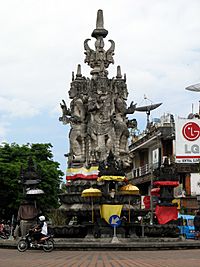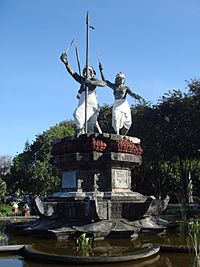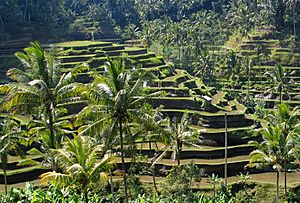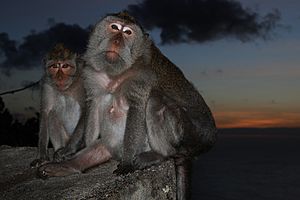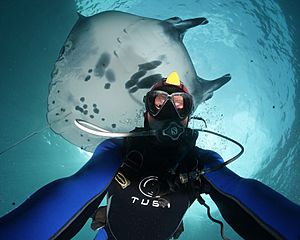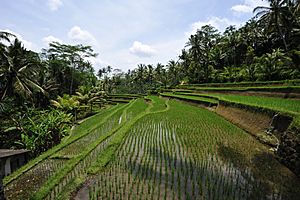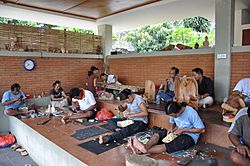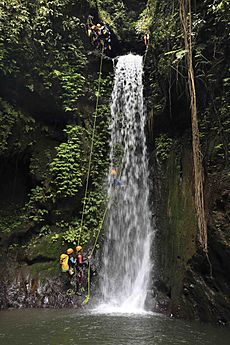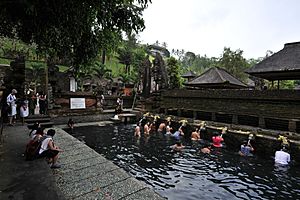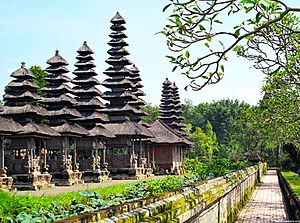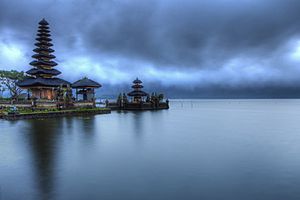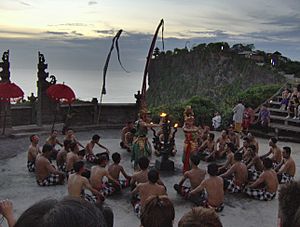Bali facts for kids
Bali is an island and a province in Indonesia. The province includes the island of Bali and a few other islands. The island is known as an island of a thousand temples. There are about 3,100,000 people in Bali. Bali's most important city is Denpasar. Hinduism is Bali's largest religion. More than 90% of its people are Hindus. Textiles and garments are 45% of their exports. The currency in Bali is the Indonesian rupiah (IDR). Bali's food mainly consists of rice and mostly spicy foods. Tourists often enjoy a local specialty called babi guling (roast pig). Bali has many fruits, such as pineapples, mangos, passionfruits, bananas, coconuts, rambutans, selaks, durians, mangosteens and different kinds of oranges and grapefruits. Bali is also known for its folk music which is played on a group of instruments called a gamelan.
Contents
History
Ancient
Bali was inhabited around 2000 BC by Austronesian people who migrated originally from Southeast Asia and Oceania through Maritime Southeast Asia. Culturally and linguistically, the Balinese are closely related to the people of the Indonesian archipelago, Malaysia, the Philippines and Oceania. Stone tools dating from this time have been found near the village of Cekik in the island's west.
In ancient Bali, nine Hindu sects existed, namely Pasupata, Bhairawa, Siwa Shidanta, Waisnawa, Bodha, Brahma, Resi, Sora and Ganapatya. Each sect revered a specific deity as its personal Godhead.
Inscriptions from 896 and 911 don't mention a king, until 914, when Sri Kesarivarma is mentioned. They also reveal an independent Bali, with a distinct dialect, where Buddhism and Sivaism were practiced simultaneously. Mpu Sindok's great-granddaughter, Mahendradatta (Gunapriyadharmapatni), married the Bali king Udayana Warmadewa (Dharmodayanavarmadeva) around 989, giving birth to Airlangga around 1001. This marriage also brought more Hinduism and Javanese culture to Bali. Princess Sakalendukirana appeared in 1098. Suradhipa reigned from 1115 to 1119, and Jayasakti from 1146 until 1150. Jayapangus appears on inscriptions between 1178 and 1181, while Adikuntiketana and his son Paramesvara in 1204.
Balinese culture was strongly influenced by Indian, Chinese, and particularly Hindu culture, beginning around the 1st century AD. The name Bali dwipa ("Bali island") has been discovered from various inscriptions, including the Blanjong pillar inscription written by Sri Kesari Warmadewa in 914 AD and mentioning "Walidwipa". It was during this time that the people developed their complex irrigation system subak to grow rice in wet-field cultivation. Some religious and cultural traditions still practiced today can be traced to this period.
The Hindu Majapahit Empire (1293–1520 AD) on eastern Java founded a Balinese colony in 1343. The uncle of Hayam Wuruk is mentioned in the charters of 1384–86. A mass Javanese immigration to Bali occurred in the next century when the Majapahit Empire fell in 1520. Bali's government then became an independent collection of Hindu kingdoms which led to a Balinese national identity and major enhancements in culture, arts, and economy. The nation with various kingdoms became independent for up to 386 years until 1906, when the Dutch subjugated and repulsed the natives for economic control and took it over.
Portuguese contacts
The first known European contact with Bali is thought to have been made in 1512, when a Portuguese expedition led by Antonio Abreu and Francisco Serrão sighted its northern shores. It was the first expedition of a series of bi-annual fleets to the Moluccas, that throughout the 16th century usually traveled along the coasts of the Sunda Islands. Bali was also mapped in 1512, in the chart of Francisco Rodrigues, aboard the expedition. In 1585, a ship foundered off the Bukit Peninsula and left a few Portuguese in the service of Dewa Agung.
Dutch East Indies
In 1597 the Dutch explorer Cornelis de Houtman arrived at Bali, and the Dutch East India Company was established in 1602. The Dutch government expanded its control across the Indonesian archipelago during the second half of the 19th century (see Dutch East Indies). Dutch political and economic control over Bali began in the 1840s on the island's north coast, when the Dutch pitted various competing Balinese realms against each other. In the late 1890s, struggles between Balinese kingdoms in the island's south were exploited by the Dutch to increase their control.
In June 1860 the famous Welsh naturalist, Alfred Russel Wallace, travelled to Bali from Singapore, landing at Buleleng on the north coast of the island. Wallace's trip to Bali was instrumental in helping him devise his Wallace Line theory. The Wallace Line is a faunal boundary that runs through the strait between Bali and Lombok. It has been found to be a boundary between species. In his travel memoir The Malay Archipelago, Wallace wrote of his experience in Bali, of which has strong mention of the unique Balinese irrigation methods:
I was both astonished and delighted; for as my visit to Java was some years later, I had never beheld so beautiful and well-cultivated a district out of Europe. A slightly undulating plain extends from the seacoast about ten or twelve miles (16 or 19 kilometres) inland, where it is bounded by a fine range of wooded and cultivated hills. Houses and villages, marked out by dense clumps of coconut palms, tamarind and other fruit trees, are dotted about in every direction; while between them extend luxurious rice-grounds, watered by an elaborate system of irrigation that would be the pride of the best cultivated parts of Europe.
The Dutch mounted large naval and ground assaults at the Sanur region in 1906 and were met by the thousands of members of the royal family and their followers. Despite Dutch demands for surrender, an estimated 200 Balinese committed ritual suicide (puputan) to avoid the humiliation. Afterward the Dutch governors exercised administrative control over the island, but local control over religion and culture generally remained intact. Dutch rule over Bali came later and was never as well established as in other parts of Indonesia such as Java and Maluku.
In the 1930s, anthropologists Margaret Mead and Gregory Bateson, artists Miguel Covarrubias and Walter Spies, and musicologist Colin McPhee all spent time here.
Imperial Japan occupied Bali during World War II. It was not originally a target in their Netherlands East Indies Campaign, but as the airfields on Borneo were inoperative due to heavy rains, the Imperial Japanese Army decided to occupy Bali, which did not suffer from comparable weather. The island had no regular Royal Netherlands East Indies Army (KNIL) troops. There was only a Native Auxiliary Corps Prajoda (Korps Prajoda) consisting of about 600 native soldiers and several Dutch KNIL officers under the command of KNIL Lieutenant Colonel W.P. Roodenburg. On 19 February 1942 the Japanese forces landed near the town of Senoer [Senur]. The island was quickly captured.
During the Japanese occupation, a Balinese military officer, Gusti Ngurah Rai, formed a Balinese 'freedom army'. The harshness of Japanese occupation forces made them more resented than the Dutch colonial rulers. Following Japan's Pacific surrender in August 1945, the Dutch returned to Indonesia, including Bali, to reinstate their pre-war colonial administration. This was resisted by the Balinese rebels, who now used captured Japanese weapons. On 20 November 1946, the Battle of Marga was fought in Tabanan in central Bali. Colonel I Gusti Ngurah Rai, by then 29 years old, finally rallied his forces in east Bali at Marga Rana, where they made a suicide attack on the heavily armed Dutch. The Balinese battalion was entirely wiped out, breaking the last thread of Balinese military resistance.
Independence from the Dutch
In 1946, the Dutch constituted Bali as one of the 13 administrative districts of the newly proclaimed State of East Indonesia, a rival state to the Republic of Indonesia, which was proclaimed and headed by Sukarno and Hatta. Bali was included in the "Republic of the United States of Indonesia" when the Netherlands recognised Indonesian independence on 29 December 1949. The first governor of Bali, Anak Agung Bagus Suteja, was appointed by President Sukarno in 1958, when Bali became a province.
Contemporary
The 1963 eruption of Mount Agung killed thousands, created economic havoc and forced many displaced Balinese to be transmigrated to other parts of Indonesia. Mirroring the widening of social divisions across Indonesia in the 1950s and early 1960s, Bali saw conflict between supporters of the traditional caste system, and those rejecting this system. Politically, the opposition was represented by supporters of the Indonesian Communist Party (PKI) and the Indonesian Nationalist Party (PNI), with tensions and ill-feeling further increased by the PKI's land reform programs. An attempted coup in Jakarta was put down by forces led by General Suharto.
The army became the dominant power as it instigated a violent anti-communist purge, in which the army blamed the PKI for the coup. Most estimates suggest that at least 500,000 people were killed across Indonesia, with an estimated 80,000 killed in Bali, equivalent to 5% of the island's population. With no Islamic forces involved as in Java and Sumatra, upper-caste PNI landlords led the extermination of PKI members.
As a result of the 1965-66 upheavals, Suharto was able to manoeuvre Sukarno out of the presidency. His "New Order" government reestablished relations with western countries. The pre-War Bali as "paradise" was revived in a modern form. The resulting large growth in tourism has led to a dramatic increase in Balinese standards of living and significant foreign exchange earned for the country. A bombing in 2002 by militant Islamists in the tourist area of Kuta killed 202 people, mostly foreigners. This attack, and another in 2005, severely reduced tourism, producing much economic hardship to the island.
Geography
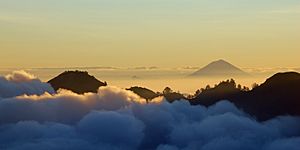
The island of Bali lies 3.2 km (2 mi) east of Java, and is approximately 8 degrees south of the equator. Bali and Java are separated by the Bali Strait. East to west, the island is approximately 153 km (95 mi) wide and spans approximately 112 km (69 mi) north to south; administratively it covers 5,780 km2, or 5,577 km2 without Nusa Penida District, its population density is roughly 750 people/km2.
Bali's central mountains include several peaks over 2,000 metres (6,600 feet) in elevation. The highest is Mount Agung (3,031 m (9,944 ft)), known as the "mother mountain" which is an active volcano rated as one of the world's most likely sites for a massive eruption within the next 100 years. Mountains range from centre to the eastern side, with Mount Agung the easternmost peak. Bali's volcanic nature has contributed to its exceptional fertility and its tall mountain ranges provide the high rainfall that supports the highly productive agriculture sector. South of the mountains is a broad, steadily descending area where most of Bali's large rice crop is grown. The northern side of the mountains slopes more steeply to the sea and is the main coffee producing area of the island, along with rice, vegetables and cattle. The longest river, Ayung River, flows approximately 75 km.
The island is surrounded by coral reefs. Beaches in the south tend to have white sand while those in the north and west have black sand. Bali has no major waterways, although the Ho River is navigable by small sampan boats. Black sand beaches between Pasut and Klatingdukuh are being developed for tourism, but apart from the seaside temple of Tanah Lot, they are not yet used for significant tourism.
The largest city is the provincial capital, Denpasar, near the southern coast. Its population is around 491,500 (2002). Bali's second-largest city is the old colonial capital, Singaraja, which is located on the north coast and is home to around 100,000 people. Other important cities include the beach resort, Kuta, which is practically part of Denpasar's urban area, and Ubud, situated at the north of Denpasar, is the island's cultural centre.
Three small islands lie to the immediate south east and all are administratively part of the Klungkung regency of Bali: Nusa Penida, Nusa Lembongan and Nusa Ceningan. These islands are separated from Bali by the Badung Strait.
To the east, the Lombok Strait separates Bali from Lombok and marks the biogeographical division between the fauna of the Indomalayan ecozone and the distinctly different fauna of Australasia. The transition is known as the Wallace Line, named after Alfred Russel Wallace, who first proposed a transition zone between these two major biomes. When sea levels dropped during the Pleistocene ice age, Bali was connected to Java and Sumatra and to the mainland of Asia and shared the Asian fauna, but the deep water of the Lombok Strait continued to keep Lombok Island and the Lesser Sunda archipelago isolated.
Climate
Being just 8 degrees south of the equator, Bali has a fairly even climate year round. Average year-round temperature stands at around 30 °C with a humidity level of about 85%.
Day time temperatures at low elevations vary between 20–33⁰ C (68–91⁰ F), although it can be much cooler than that in the mountains. The west monsoon is in place from approximately October to April, and this can bring significant rain, particularly from December to March. Outside of the monsoon period, humidity is relatively low and any rain is unlikely in lowland areas.
The high season in Bali is during the "dry season" in July and August, as well as during the Easter and Christmas holidays, when the weather is very unpredictable.
Ecology
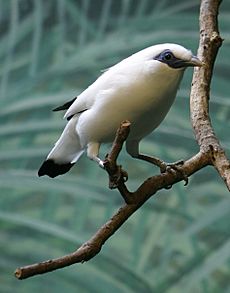
Bali lies just to the west of the Wallace Line, and thus has a fauna that is Asian in character, with very little Australasian influence, and has more in common with Java than with Lombok. An exception is the yellow-crested cockatoo, a member of a primarily Australasian family. There are around 280 species of birds, including the critically endangered Bali myna, which is endemic. Others Include barn swallow, black-naped oriole, black racket-tailed treepie, crested serpent-eagle, crested treeswift, dollarbird, Java sparrow, lesser adjutant, long-tailed shrike, milky stork, Pacific swallow, red-rumped swallow, sacred kingfisher, sea eagle, woodswallow, savanna nightjar, stork-billed kingfisher, yellow-vented bulbul and great egret.
Until the early 20th century, Bali was home to several large mammals: the wild banteng, leopard and the endemic Bali tiger. The banteng still occurs in its domestic form, whereas leopards are found only in neighbouring Java, and the Bali tiger is extinct. The last definite record of a tiger on Bali dates from 1937, when one was shot, though the subspecies may have survived until the 1940s or 1950s. The relatively small size of the island, conflict with humans, poaching and habitat reduction drove the Bali tiger to extinction. This was the smallest and rarest of all tiger subspecies and was never caught on film or displayed in zoos, and few skins or bones remain in museums around the world. Today, the largest mammals are the Javan rusa deer and the wild boar.
Squirrels are quite commonly encountered, less often is the Asian palm civet, which is also kept in coffee farms to produce Kopi Luwak. Bats are well represented, perhaps the most famous place to encounter them remaining the Goa Lawah (Temple of the Bats) where they are worshipped by the locals and also constitute a tourist attraction. They also occur in other cave temples, for instance at Gangga Beach. Two species of monkey occur. The crab-eating macaque, known locally as "kera", is quite common around human settlements and temples, where it becomes accustomed to being fed by humans, particularly in any of the three "monkey forest" temples, such as the popular one in the Ubud area. They are also quite often kept as pets by locals. The second monkey, endemic to Java and some surrounding islands such as Bali, is far rarer and more elusive is the Javan langur, locally known as "lutung". They occur in few places apart from the Bali Barat National Park. They are born an orange colour, though by their first year they would have already changed to a more blackish colouration. In Java however, there is more of a tendency for this species to retain its juvenile orange colour into adulthood, and so you can see a mixture of black and orange monkeys together as a family. Other rarer mammals include the leopard cat, Sunda pangolin and black giant squirrel.
Snakes include the king cobra and reticulated python. The water monitor can grow to at least 1.5 m (4.9 ft) in length and 50 kg (110 lb) and can move quickly.
The rich coral reefs around the coast, particularly around popular diving spots such as Tulamben, Amed, Menjangan or neighbouring Nusa Penida, host a wide range of marine life, for instance hawksbill turtle, giant sunfish, giant manta ray, giant moray eel, bumphead parrotfish, hammerhead shark, reef shark, barracuda, and sea snakes. Dolphins are commonly encountered on the north coast near Singaraja and Lovina.
A team of scientists conducted a survey from 29 April 2011 to 11 May 2011 at 33 sea sites around Bali. They discovered 952 species of reef fish of which 8 were new discoveries at Pemuteran, Gilimanuk, Nusa Dua, Tulamben and Candidasa, and 393 coral species, including two new ones at Padangbai and between Padangbai and Amed. The average coverage level of healthy coral was 36% (better than in Raja Ampat and Halmahera by 29% or in Fakfak and Kaimana by 25%) with the highest coverage found in Gili Selang and Gili Mimpang in Candidasa, Karangasem regency.
Many plants have been introduced by humans within the last centuries, particularly since the 20th century, making it sometimes hard to distinguish what plants are really native. Among the larger trees the most common are: banyan trees, jackfruit, coconuts, bamboo species, acacia trees and also endless rows of coconuts and banana species. Numerous flowers can be seen: hibiscus, frangipani, bougainvillea, poinsettia, oleander, jasmine, water lily, lotus, roses, begonias, orchids and hydrangeas exist. On higher grounds that receive more moisture, for instance around Kintamani, certain species of fern trees, mushrooms and even pine trees thrive well. Rice comes in many varieties. Other plants with agricultural value include: salak, mangosteen, corn, kintamani orange, coffee and water spinach.
Environment
Some of the worst erosion has occurred in Lebih Beach, where up to seven metres (23 feet) of land is lost every year. Decades ago, this beach was used for holy pilgrimages with more than 10,000 people, but they have now moved to Masceti Beach.
From ranked third in previous review, in 2010 Bali got score 99.65 of Indonesia's environmental quality index and the highest of all the 33 provinces. The score measured 3 water quality parameters: the level of total suspended solids (TSS), dissolved oxygen (DO) and chemical oxygen demand (COD).
Because of over-exploitation by the tourist industry which covers a massive land area, 200 out of 400 rivers on the island have dried up and based on research, the southern part of Bali would face a water shortage up to 2,500 litres of clean water per second by 2015. To ease the shortage, the central government plans to build a water catchment and processing facility at Petanu River in Gianyar. The 300 litres capacity of water per second will be channelled to Denpasar, Badung and Gianyar in 2013.
Economy
Three decades ago, the Balinese economy was largely agriculture-based in terms of both output and employment. Tourism is now the largest single industry in terms of income, and as a result, Bali is one of Indonesia's wealthiest regions. In 2003, around 80% of Bali's economy was tourism related. By end of June 2011, non-performing loan of all banks in Bali were 2.23%, lower than the average of Indonesian banking industry non-performing loan (about 5%). The economy, however, suffered significantly as a result of the terrorist bombings 2002 and 2005. The tourism industry has since recovered from these events.
Agriculture
Although tourism produces the GDP's largest output, agriculture is still the island's biggest employer; Fishing also provides a significant number of jobs. Bali is also famous for its artisans who produce a vast array of handicrafts, including batik and ikat cloth and clothing, wooden carvings, stone carvings, painted art and silverware. Notably, individual villages typically adopt a single product, such as wind chimes or wooden furniture.
The Arabica coffee production region is the highland region of Kintamani near Mount Batur. Generally, Balinese coffee is processed using the wet method. This results in a sweet, soft coffee with good consistency. Typical flavours include lemon and other citrus notes. Many coffee farmers in Kintamani are members of a traditional farming system called Subak Abian, which is based on the Hindu philosophy of "Tri Hita Karana". According to this philosophy, the three causes of happiness are good relations with God, other people, and the environment. The Subak Abian system is ideally suited to the production of fair trade and organic coffee production. Arabica coffee from Kintamani is the first product in Indonesia to request a geographical indication.
Tourism
In 1963 the Bali Beach Hotel in Sanur was built by Sukarno, and boosted tourism in Bali. Prior to it, only three hotels existed on the island. Construction of hotels and restaurants began to spread throughout Bali. Tourism further increased on Bali after the Ngurah Rai International Airport opened in 1970. The Buleleng regency government encouraged the tourism sector as one of the mainstays for economic progress and social welfare.
The tourism industry is primarily focused in the south, while significant in the other parts of the island as well. The main tourist locations are the town of Kuta (with its beach), and its outer suburbs of Legian and Seminyak (which were once independent townships), the east coast town of Sanur (once the only tourist hub), Ubud towards the center of the island, to the south of the Ngurah Rai International Airport, Jimbaran, and the newer developments of Nusa Dua and Pecatu.
The United States government lifted its travel warnings in 2008. The Australian government issued an advisory on Friday, 4 May 2012, with the overall level of this advisory lowered to 'Exercise a high degree of caution'. The Swedish government issued a new warning on Sunday, 10 June 2012 because of one tourist who died from methanol poisoning. Australia last issued an advisory on Monday, 5 January 2015 due to new terrorist threats.

is a popular tourist spot in Bali]]An offshoot of tourism is the growing real estate industry. Bali's real estate has been rapidly developing in the main tourist areas of Kuta, Legian, Seminyak and Oberoi. Most recently, high-end 5-star projects are under development on the Bukit peninsula, on the south side of the island. Million dollar villas are being developed along the cliff sides of south Bali, with commanding panoramic ocean views. Foreign and domestic (many Jakarta individuals and companies are fairly active) investment into other areas of the island also continues to grow. Land prices, despite the worldwide economic crisis, have remained stable.
In the last half of 2008, Indonesia's currency had dropped approximately 30% against the US dollar, providing many overseas visitors value for their currencies. Visitor arrivals for 2009 were forecast to drop 8% (which would be higher than 2007 levels), mainly due to the worldwide economic crisis which has also affected the global tourist industry.
Bali's tourism economy survived the terrorist bombings of 2002 and 2005, and the tourism industry has in fact slowly recovered and surpassed its pre-terrorist bombing levels; the longterm trend has been a steady increase of visitor arrivals. In 2010, Bali received 2.57 million foreign tourists, which surpassed the target of 2.0–2.3 million tourists. The average occupancy of starred hotels achieved 65%, so the island still should be able to accommodate tourists for some years without any addition of new rooms/hotels, although at the peak season some of them are fully booked.
Bali received the Best Island award from Travel and Leisure in 2010. Bali won because of its attractive surroundings (both mountain and coastal areas), diverse tourist attractions, excellent international and local restaurants, and the friendliness of the local people. According to BBC Travel released in 2011, Bali is one of the World's Best Islands, ranking second after Santorini, Greece.
In August 2010, the film Eat Pray Love was released in theatres. The movie was based on Elizabeth Gilbert's best-selling memoir Eat, Pray, Love. It took place at Ubud and Padang-Padang Beach at Bali. The 2006 book, which spent 57 weeks at the No. 1 spot on the New York Times paperback nonfiction best-seller list, had already fuelled a boom in Eat, Pray, Love-related tourism in Ubud, the hill town and cultural and tourist center that was the focus of Gilbert's quest for balance through traditional spirituality and healing that leads to love.
In January 2016, after music icon David Bowie died, it was revealed that in his will, Bowie asked for his ashes to be scattered in Bali, conforming to Buddhist rituals. He had visited and performed in a number of Southeast Asian cities early in his career, including Bangkok and Singapore.
Since 2011, China has displaced Japan as the second-largest supplier of tourists to Bali, while Australia still tops the list. Chinese tourists increased by 17% from last year due to the impact of ACFTA and new direct flights to Bali. In January 2012, Chinese tourists year on year (yoy) increased by 222.18% compared to January 2011, while Japanese tourists declined by 23.54% yoy.
Bali reported that it welcomed 2.88 million foreign tourists and 5 million domestic tourists in 2012, marginally surpassing the expectations of 2.8 million foreign tourists.
Based on a Bank Indonesia survey in May 2013, 34.39 percent of tourists are upper-middle class, spending between $1,286 to $5,592, and are dominated by Australia, France, China, Germany and the US. Some Chinese tourists have increased their levels of spending from previous years. 30.26 percent of tourists are middle class, spending between $662 to $1,285.
Transportation
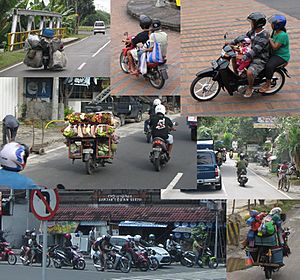
The Ngurah Rai International Airport is located near Jimbaran, on the isthmus at the southernmost part of the island. Lt.Col. Wisnu Airfield is found in north-west Bali.
A coastal road circles the island, and three major two-lane arteries cross the central mountains at passes reaching to 1,750m in height (at Penelokan). The Ngurah Rai Bypass is a four-lane expressway that partly encircles Denpasar. Bali has no railway lines.
In May 2011, an integrated Aerial Traffic Control System (ATCS) was implemented to reduce traffic jams at four crossing points: Ngurah Rai statue, Dewa Ruci Kuta crossing, Jimbaran crossing and Sanur crossing. ATCS is an integrated system connecting all traffic lights, CCTVs and other traffic signals with a monitoring office at the police headquarters. It has successfully been implemented in other ASEAN countries and will be implemented at other crossings in Bali.
To solve chronic traffic problems, the province will also build a toll road connecting Serangan with Tohpati, a toll road connecting Kuta, Denpasar and Tohpati and a flyover connecting Kuta and Ngurah Rai Airport.
Demographics
The population of Bali was 3,890,757 as of the 2010 Census; the latest estimate (for January 2014) is 4,225,384. There are an estimated 30,000 expatriates living in Bali.
Ethnic origins
A DNA study in 2005 by Karafet et al. found that 12% of Balinese Y-chromosomes are of likely Indian origin, while 84% are of likely Austronesian origin, and 2% of likely Melanesian origin. The study does not correlate the DNA samples to the Balinese caste system.
Caste system
Bali has a caste system based on the Indian Hindu model, with four castes:
- Sudra (Shudra) – peasants constituting close to 93% of Bali's population.
- Wesia (Vaishyas) – the caste of merchants and administrative officials
- Ksatrias (Kshatriyas) – the kingly and warrior caste
- Brahmana (Brahmin) – holy men and priests
Nowadays, the caste system is used more in religious settings where the members of the lower caste would ask the members of the Brahman caste (the Pedandas) to conduct ceremonies.
Religion
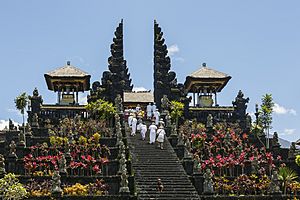
Unlike most of Muslim-majority Indonesia, about 83.5% of Bali's population adheres to Balinese Hinduism, formed as a combination of existing local beliefs and Hindu influences from mainland Southeast Asia and South Asia. Minority religions include Islam (13.37%), Christianity (2.47%), and Buddhism (0.5%). These figures do not include immigrants from other parts of Indonesia.
Balinese Hinduism is an amalgam in which gods and demigods are worshipped together with Buddhist heroes, the spirits of ancestors, indigenous agricultural deities and sacred places. Religion as it is practised in Bali, is a composite belief system that embraces not only theology, philosophy, and mythology, but ancestor worship, animism and magic. It pervades nearly every aspect of traditional life. Caste is observed, though less strictly than in India. With an estimated 20,000 puras (temples) and shrines, Bali is known as the "Island of a Thousand Puras", or "Island of the Gods".
Balinese Hinduism has roots in Indian Hinduism and Buddhism, and adopted the animistic traditions of the indigenous people. This influence strengthened the belief that the gods and goddesses are present in all things. Every element of nature, therefore, possesses its own power, which reflects the power of the gods. A rock, tree, dagger, or woven cloth is a potential home for spirits whose energy can be directed for good or evil. Balinese Hinduism is deeply interwoven with art and ritual. Ritualizing states of self-control are a notable feature of religious expression among the people, who for this reason have become famous for their graceful and decorous behaviour.
Apart from the majority of Balinese Hindus, there also exist Chinese immigrants whose traditions have melded with that of the locals. As a result, these Sino-Balinese not only embrace their original religion, which is a mixture of Buddhism, Christianity, Taoism and Confucianism, but also find a way to harmonise it with the local traditions. Hence, it is not uncommon to find local Sino-Balinese during the local temple's odalan. Moreover, Balinese Hindu priests are invited to perform rites alongside a Chinese priest in the event of the death of a Sino-Balinese. Nevertheless, the Sino-Balinese claim to embrace Buddhism for administrative purposes, such as their Identity Cards.
Language
Balinese and Indonesian are the most widely spoken languages in Bali, and the vast majority of Balinese people are bilingual or trilingual. The most common spoken language around the tourist areas is Indonesian, as many people in the tourist sector are not solely Balinese, but migrants from Java, Lombok, Sumatra, and other parts of Indonesia. There are several indigenous Balinese languages, but most Balinese can also use the most widely spoken option: modern common Balinese. The usage of different Balinese languages was traditionally determined by the Balinese caste system and by clan membership, but this tradition is diminishing. Kawi and Sanskrit are also commonly used by some Hindu priests in Bali, for Hinduism literature was mostly written in Sanskrit.
English and Chinese are the next most common languages (and the primary foreign languages) of many Balinese, owing to the requirements of the tourism industry, as well as the English-speaking community and huge Chinese-Indonesian population. Other foreign languages, such as Japanese, Korean, French, Russian or German are often used in multilingual signs for foreign tourists.
Culture
Bali is renowned for its diverse and sophisticated art forms, such as painting, sculpture, woodcarving, handcrafts, and performing arts. Balinese cuisine is also distinctive. Balinese percussion orchestra music, known as gamelan, is highly developed and varied. Balinese performing arts often portray stories from Hindu epics such as the Ramayana but with heavy Balinese influence. Famous Balinese dances include pendet, legong, baris, topeng, barong, gong keybar, and kecak (the monkey dance). Bali boasts one of the most diverse and innovative performing arts cultures in the world, with paid performances at thousands of temple festivals, private ceremonies, or public shows.
The Hindu New Year, Nyepi, is celebrated in the spring by a day of silence. On this day everyone stays at home and tourists are encouraged to remain in their hotels. On the day before New Year, large and colourful sculptures of ogoh-ogoh monsters are paraded and finally burned in the evening to drive away evil spirits. Other festivals throughout the year are specified by the Balinese pawukon calendrical system.
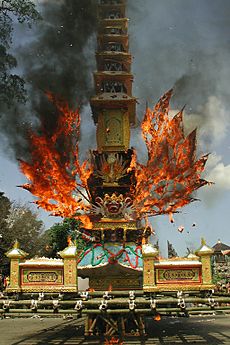
Celebrations are held for many occasions such as a tooth-filing (coming-of-age ritual), cremation or odalan (temple festival). One of the most important concepts that Balinese ceremonies have in common is that of désa kala patra, which refers to how ritual performances must be appropriate in both the specific and general social context. Many of the ceremonial art forms such as wayang kulit and topeng are highly improvisatory, providing flexibility for the performer to adapt the performance to the current situation. Many celebrations call for a loud, boisterous atmosphere with lots of activity and the resulting aesthetic, ramé, is distinctively Balinese. Often two or more gamelan ensembles will be performing well within earshot, and sometimes compete with each other to be heard. Likewise, the audience members talk amongst themselves, get up and walk around, or even cheer on the performance, which adds to the many layers of activity and the liveliness typical of ramé.
Kaja and kelod are the Balinese equivalents of North and South, which refer to ones orientation between the island's largest mountain Gunung Agung (kaja), and the sea (kelod). In addition to spatial orientation, kaja and kelod have the connotation of good and evil; gods and ancestors are believed to live on the mountain whereas demons live in the sea. Buildings such as temples and residential homes are spatially oriented by having the most sacred spaces closest to the mountain and the unclean places nearest to the sea.
Most temples have an inner courtyard and an outer courtyard which are arranged with the inner courtyard furthest kaja. These spaces serve as performance venues since most Balinese rituals are accompanied by any combination of music, dance and drama. The performances that take place in the inner courtyard are classified as wali, the most sacred rituals which are offerings exclusively for the gods, while the outer courtyard is where bebali ceremonies are held, which are intended for gods and people. Lastly, performances meant solely for the entertainment of humans take place outside the walls of the temple and are called bali-balihan. This three-tiered system of classification was standardised in 1971 by a committee of Balinese officials and artists to better protect the sanctity of the oldest and most sacred Balinese rituals from being performed for a paying audience.
Tourism, Bali's chief industry, has provided the island with a foreign audience that is eager to pay for entertainment, thus creating new performance opportunities and more demand for performers. The impact of tourism is controversial since before it became integrated into the economy, the Balinese performing arts did not exist as a capitalist venture, and were not performed for entertainment outside of their respective ritual context. Since the 1930s sacred rituals such as the barong dance have been performed both in their original contexts, as well as exclusively for paying tourists. This has led to new versions of many of these performances which have developed according to the preferences of foreign audiences; some villages have a barong mask specifically for non-ritual performances as well as an older mask which is only used for sacred performances.
Balinese society continues to revolve around each family's ancestral village, to which the cycle of life and religion is closely tied. Coercive aspects of traditional society, such as customary law sanctions imposed by traditional authorities such as village councils (including "kasepekang", or shunning) have risen in importance as a consequence of the democratisation and decentralisation of Indonesia since 1998.
Sports
Bali is a major world surfing destination with popular breaks dotted across the southern coastline and around the offshore island of Nusa Lembongan.
As part of the Coral Triangle, Bali, including Nusa Penida, offers a wide range of dive sites with varying types of reefs.
Bali was the host of 2008 Asian Beach Games. It was the second time Indonesia hosted an Asia-level multi-sport event, after Jakarta held the 1962 Asian Games.
In football, Bali is home to the football club Bali United, which plays in the Liga 1. The team was relocated from Samarinda, East Kalimantan to Gianyar, Bali. Harbiansyah Hanafiah, the main commissioner of Bali United explained that he did the name change and moved the homebase to Bali because there were no representative from Bali in the highest football tier in Indonesia. Another reason was due to local fans in Samarinda prefer to support Pusamania Borneo F.C. more than Persisam.
Heritage sites
In June 2012, Subak, the irrigation system for paddy fields in Bali was enlisted as a Natural UNESCO world heritage site.
Beauty pageant
Bali was the host of Miss World 2013 (63rd edition of the Miss World pageant). It was the first time Indonesia hosted an international beauty pageant.
Images for kids
-
The cliff of Nusa Penida with Kelingking beach at the foreground
-
Kuta Beach is a popular tourist spot.
-
Several tourist spot in Bali island, from top left to right: Sunset over Amed beach with Mount Agung in the background, Garuda Wisnu Kencana monument, Tanah Lot temple, view from top of Besakih Temple, scuba diving around Pemuteran, The Rock Bar at Jimbaran Bay, and various traditional Balinese people activities
-
Ogoh-ogoh procession on the eve of Nyepi
-
Balinese family after performing puja in a temple
-
The Mother Temple of Besakih, one of Bali's most significant Hindu temples.
-
Cremation ceremony in Nusa Penida
See also
 In Spanish: Provincia de Bali para niños
In Spanish: Provincia de Bali para niños



